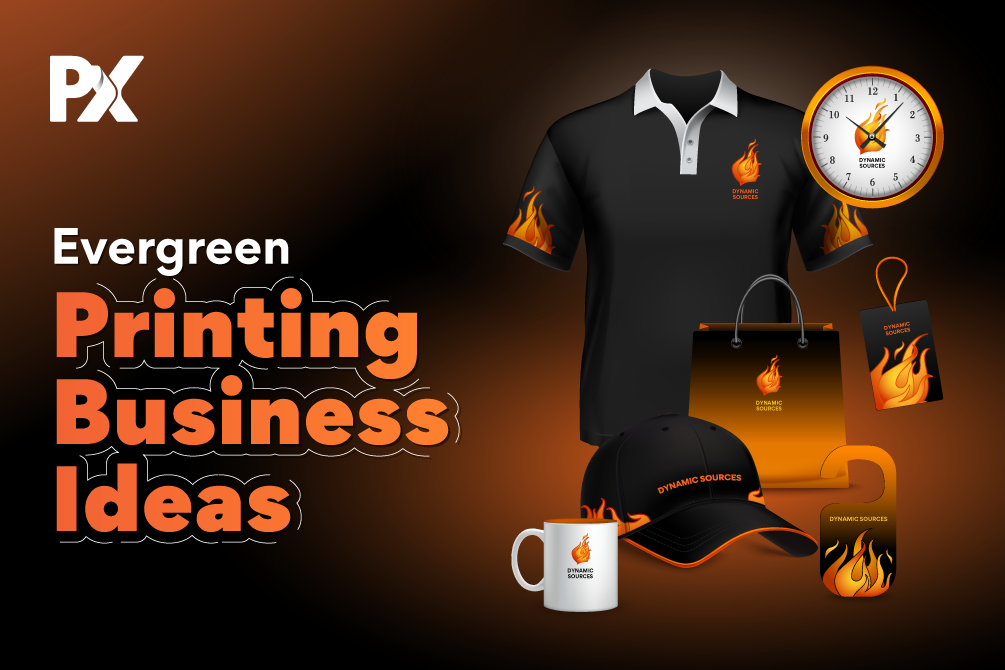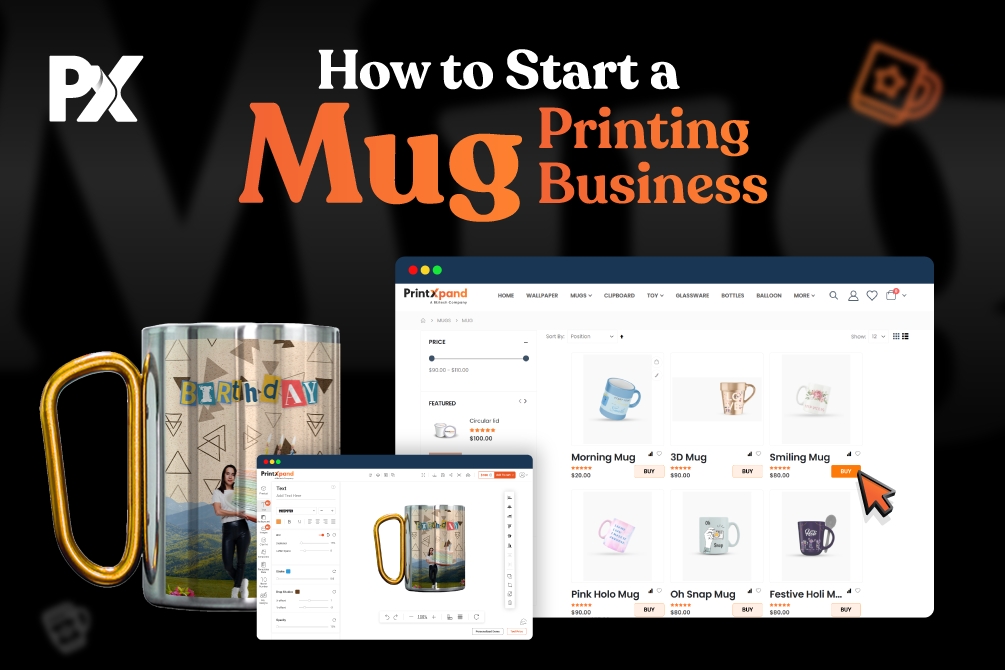- Summary
- Steps to Start Online T-Shirt Printing Business
- Step 1: Create a Business Plan
- Step 2: Decide on The eCommerce Solution for Your Web Store
- Step 3: Invest in a Product Designer Tool or a 3D Configurator
- Step 4: Make your design tool feature-rich
- Step 5: Select the t-shirt printing methods you will use
- Step 6: Select the right t-shirt supplier
- Step 7. Set Up The Printing Infrastructure
- Step 8: Set Up Logistics Infrastructure
- Step 9: Launch Your Store
- Step 10: Marketing Your Store
- To Conclude
Summary
Did you know that the T-shirt printing market is growing exponentially and is bringing newer opportunities for eCommerce businesses?
The market was worth USD 6.3 billion in 2024 and is projected to grow even more, exceeding USD 7.01 billion by 2034.
It’s clear that more and more people are getting into the trend of custom t-shirts, and businesses are noticing this shift.
This also indicates that there is a lot of money to be made in this industry.
But with so many factors to consider, such as choosing the right equipment, finding the perfect niche, and setting up your online store, getting started can be overwhelming. In short, building a solid tshirt printing business plan is extremely challenging without the right guidance.
That’s why we’ve put together this step-by-step guide on how to start t-shirt printing business with confidence and ease.
So, let’s dive in!
Steps to Start Online T-Shirt Printing Business
Basic logo t-shirts are a thing of the past. The modern t-shirt printing industry is all about print-on-demand innovation, trending designs, and limited drops. The game has changed, with micro-brands gaining cult followings overnight and creators converting $30 custom tees into $500k monthly revenue streams.
If you are ready to jump into the t-shirt printing business and want to learn the step-by-step of how to get started, then, you have landed at the right place. This guide cuts through the clutter, covering everything from different t-shirt printing methods to picking the design tool and much more!
Let’s get started.
Step 1: Create a Business Plan
To become successful in any business, it is important to have a robust business plan. However, when starting your t-shirt business, you must remember that the audience is broad. You need to target the audience based on their preferred quality, trending designs, and style.
Thus, you need a detailed business plan for the t-shirt business that includes all the factors mentioned below.
You need to decide whether you will have your own web store for selling printed t-shirts or whether you will sell the products with eCommerce sites like Amazon. Once you decide that, the next steps are:
A. Identify the market niche
There are two major ways to segment the market
- Based on the needs of the customers
- Based on the age of the customers. if you want to cater a wider audience you need to target multilingual audience and for that you can learn different Duolingo languages and print on the t-shirts in different languages
Niche Market Ideas for Your T-shirt Store
|
Category |
Idea In Action |
|---|---|
| Lifestyle | Tees by Never Lose Hope Designs |
| Sports and workout | Workout t-shirt by GetCustomTees |
| Organic and eco-friendly tees | Organic tees by Organic Basics |
| T-shirts for rare conditions | StomaStoma – T-shirt supporting people who have undergone tracheostomy |
| T-shirt for pet lovers | Apparel for Dog Lover by Luv the Paw |
In order to identify the market niche, make sure you ask yourself the following questions:
- Will you sell printed t-shirts to infants and toddlers or youth, teens and adults?
- Will your customers have the liberty to design their own t-shirts or will you have a fixed range of designs to choose from?
- Will you be targeting a niche within different age groups? For eg, Printed rock band t-shirts for teens or printed sport t-shirts for adults.
- Will the fashion and quality of the printed t-shirts meet the current market trends?
- What is the budget of your target customer? What is the price point that they are willing to pay for your t-shirts?
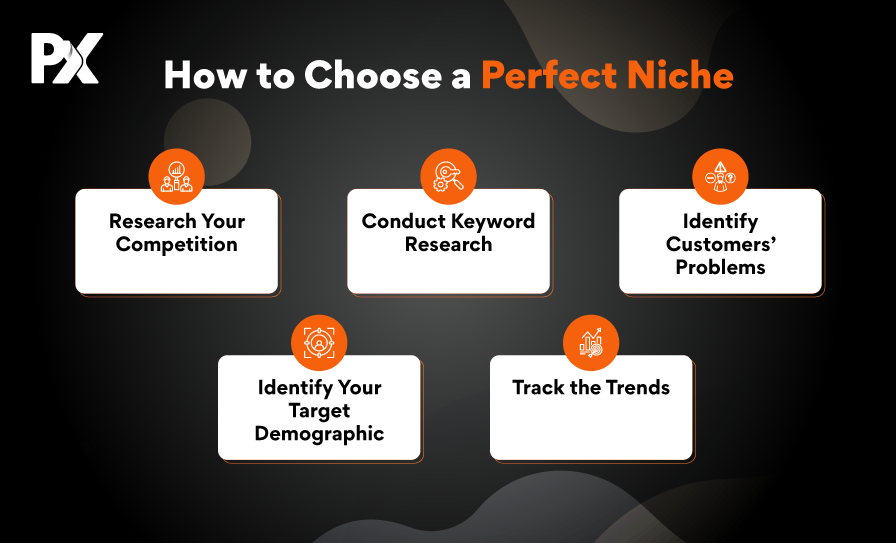
More tips for identifying your business niche
One of the basic steps is to start keyword research. You can use Google Keyword Planner for that.
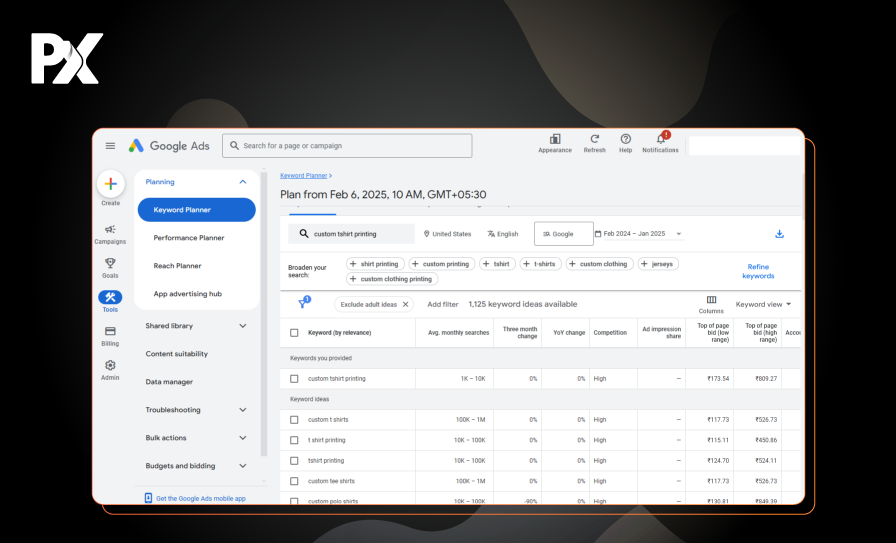
- Add in some keywords related to your niche, add targeted countries, and see which words and phrases are suggested. Further, narrow the suggestions by monthly search volume, competition level, and suggested bid.
- Focus on primary keywords with 1K-10K monthly search volume, but don’t forget to mix in LSI keywords that have less than 1K searches. This approach will help you get a balanced search traffic on your store. Further, you can tap into the lower-competition keywords and get better rankings.
- With competition you get ideas about your competitors, and with suggested big you can get the idea of a high level of commercial intent.
Launch your t-shirt store with the unique edge of a personalization tool!
Once the industry and market research is done, you need to put together the tshirt printing business plan. Here are some things to consider when creating a custom printed t-shirt plan:
-
- The mission of your company – which can involve offering high quality printed t-shirts at cost-effective prices
- Will you create the basic templates and design or purchase pre-made designs?
- What to expect from yourself, the management team, and other employees.
- Know where you will obtain your raw materials from. Will you have a fixed vendor, or will you be buying plain t-shirts from a particular brand?
- Create marketing ideas based on marketing analysis by using events, social media, fairs, conventions etc… You can also use social media scheduler for better productivity by scheduling your social content in advance to make social media activities easy.
- Analyze the competition and know how will you make your brand stand out from other t-shirt companies
- Gather supporting documents like design samples, vendor agreements, and statistical analysis of the t-shirt printing business
- Obtain a license applicable to your location and type of business.
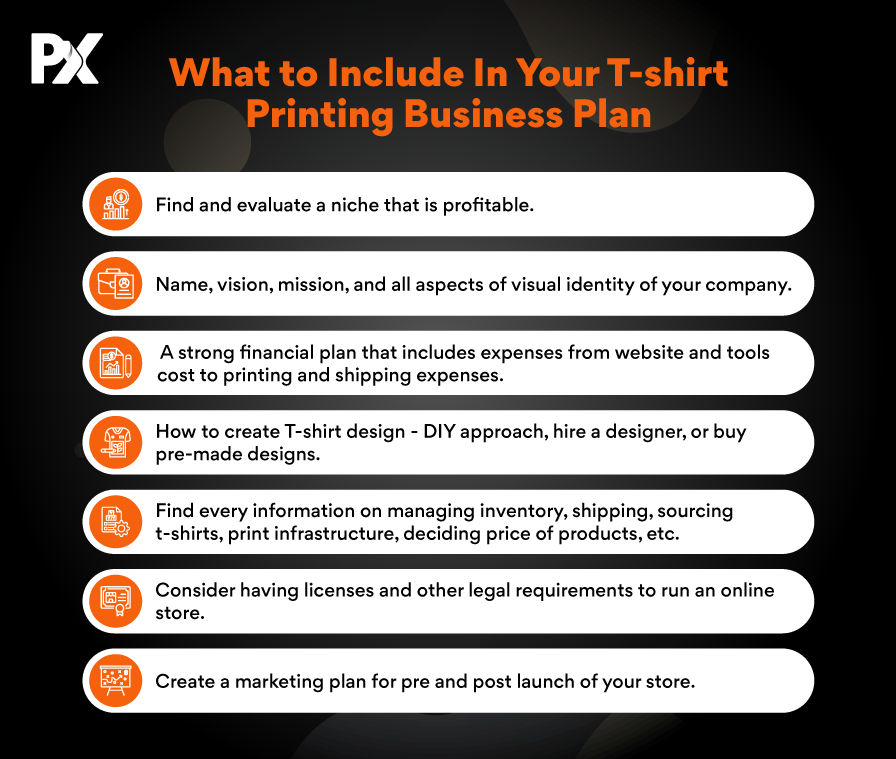
B. Consider the financial aspects
Before establishing a business like this, it is very important to have an idea as to what everything will cost you. If you are an entrepreneur who thinks in a long run, your financial strategy should include the following:
- Projected expenses and assumptions of fixed and varying costs
- Costs of investment
- Revenues goals and revenue resources
- Break-even analysis
- Business ratios including inventory turnover, accounts payable and debt ratio
- Monthly profit or loss figures
- Annual gross margin
The main expenses that you would want to add would be:
- Printing
- Bagging
- Tagging
- Labeling
- Packing
- Shipping
- Tax
You can get printing quotes from different t-shirt printing firms so that you can compare prices and give the best deal without compromising on the quality. Once you work out the above aspects, it will help you to decide on the prices you should quote for your t-shirts.
Starting your business in the upcoming year can be challenging because the world economy is on the verge of recession. So, you must take care of every minute detail for launching a successful venture.
However, a recession is also a good time to start because of the availability of resources at cheaper rates. Thus, upcoming economic downfall can also help you in building a penetration pricing strategy and selling quality pullovers at lower rates.
C. Don’t make these mistakes
If you have a robust tshirt printing business plan, you will undergo each step of the planning process. There are times when startups or entrepreneurs handling one-man businesses think that there is no need to have a business plan. However, this is not the right approach. Make sure you do not make the following mistakes.
- Not indulging into market research or having a profit and loss projection
- Not branding your business enough (Will elaborate this more later in the post)
- Not establishing a professional brand image with logo, theme and mission
- Commencing business before knowing how to accept and fill shipping orders
- Opening an online store without integrating a web-to-print software
- Not having enough t-shirt design templates, colour options and cliparts
- Lack of knowledge about the working of web to print software and its maintenance
- Not checking the quality of final output (printed t-shirts)
- Not taking into account the challenges that any business must know how to cope with
Step 2: Decide on The eCommerce Solution for Your Web Store
The second most important thing to do is know about the eCommerce platforms you will use for your t-shirt printing e-store. Here, you have two options:
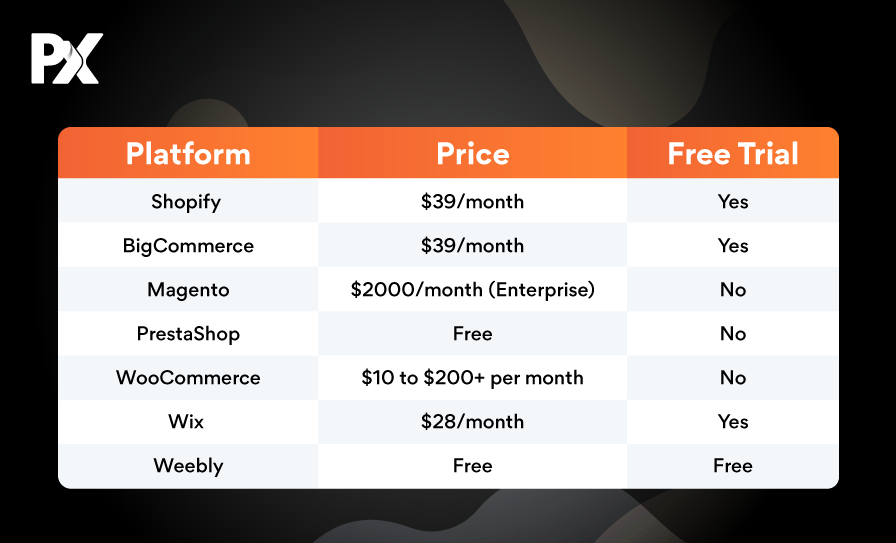
A. Choosing a Hosted Platform
Shopify and BigCommerce are the biggest example of hosted platforms. The biggest benefit of using these platforms is that they have a very low startup cost. You can purchase a store, upload the logo of your brand, pick the theme you like and start selling printed t-shirts on the platform.
Hosted platforms are ideal for start ups and will get you up and running. The only drawback with these platforms is that you can’t have an individual design of your choice and cannot add other customized elements to your store. However, you can choose out of different plans and have a great looking store.
B. Having a Self-hosted Platform
You can also have a custom developed Ecommerce solution for your business. Needless to say, it will let you have your own design, provide with the liberty of making custom edits, give limitless options pertaining to SEO and will enable you to add products and set prices at your convenience.
Expensive start up cost is a drawback here. So if you have enough funds and are confident about your business’s bright future, you can consider having a self-hosted platform.
If you’re looking for a custom solution, PrintXpand can be a good choice.
With its user-friendly interface and customizable design, this platform makes selling t-shirts online a breeze. Advanced features like social media integration and mobile responsiveness give you the competitive edge you need to succeed.
With a user-friendly interface, customizable design, and advanced features like social media integration and mobile responsiveness, it’s the perfect platform to help you succeed in the competitive world of online t-shirt sales.
Step 3: Invest in a Product Designer Tool or a 3D Configurator
There is nothing better than investing into an advanced product designer tool when you are into the business of selling customized t-shirts. You can make your online store stand out from others and add a dash of personal touch by allowing your customers to design their own t-shirt.
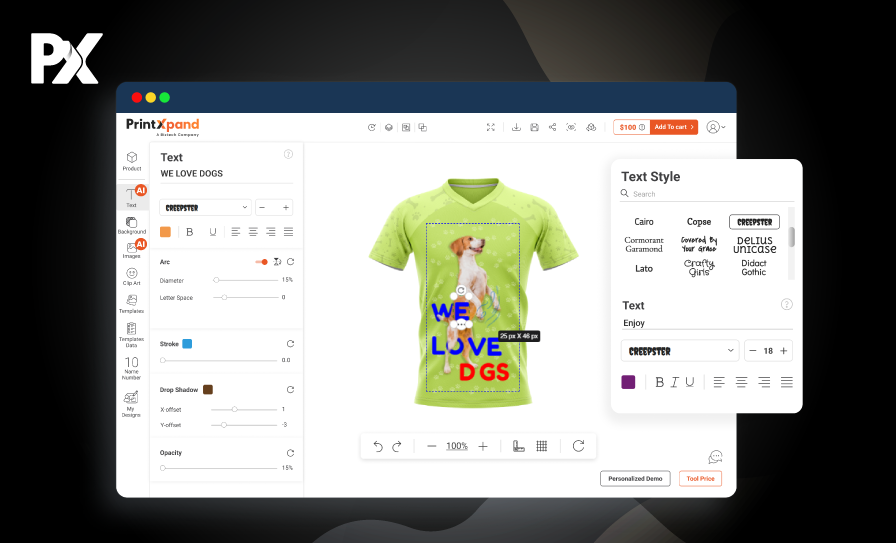
(Feature-rich and Easy-to Use Product Design Tool By PrintXpand)
Initially, you can purchase an online t-shirt design tool that fulfills the basic requirements of your customers. Thereafter, if your business is doing well, you can enhance your web-to-print software and add new features to it. As your loyal customer base would be established by then, adding new features will help you to boost your revenue.
Thus, a web to print designer tool can make your offerings even more unique. This personalized experience can help you deliver a great customer experience.
Want to see how easy custom t-shirt printing can be?
Watch this video to learn more!
Here’s a case study that would further clarify how useful PrintXpand’s design tool is for businesses in the T-shirt printing industry!
Rafasshop is a company that prints T-shirts for advertising. They were looking for a tool that allows customers to customize the T-shirts smoothly without affecting the website’s loading speed.
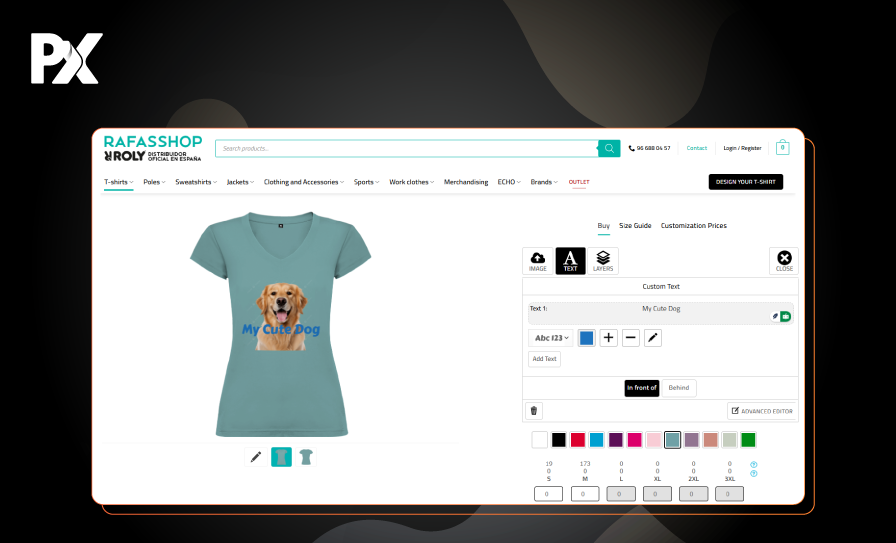
Although they already had a eCommerce store, the Product Designer Tool integrated with their existing store seamlessly. And it turned out to be a great investment for their business! Why?
Because they experienced a transformation in their business operations with the use of this tool. Here’s how:
- Easy Customization and Ordering: The designer tool’s user-friendly interface made it super easy for customers to personalize designs and place their orders with a click.
- Better Sales Without Promotion: The business started receiving an impressive number of orders even without promoting the tool or giving elaborate tutorials on how it works.
- Streamlined Pre-Press Process: The entire pre-press workflow became much more efficient than before.
- Print-Ready Files: All the received orders included editable, print-ready files, saving product time and effort.
Now, imagine the customer base you can build for your t-shirt printing business, by providing such a distinct experience!
Step 4: Make your design tool feature-rich
While designing t-shirts, people love experimenting with colors, designs, and templates. So, make sure that the tool incorporates a lot of user-friendly features. It will simply help you to win in the online t-shirt business.
You can provide ready-made quotes, clipart, texts and fonts of different styles, graphics etc. Features like masking effects, shadows and overlapping can also be added to make their designs look interesting.
One major thing you should not miss out on is the graphics part. Because this product is all about offering visually appealing products that your customers can easily create.
Additionally, the tool allows customers to design both the front and back of the t-shirt and save their designs for later.
For an even more immersive experience, you can also integrate a 3D configurator.
The tool lets customers configure the t-shirt from scratch, choosing the pattern, fabric, and designs for each part of the shirt.
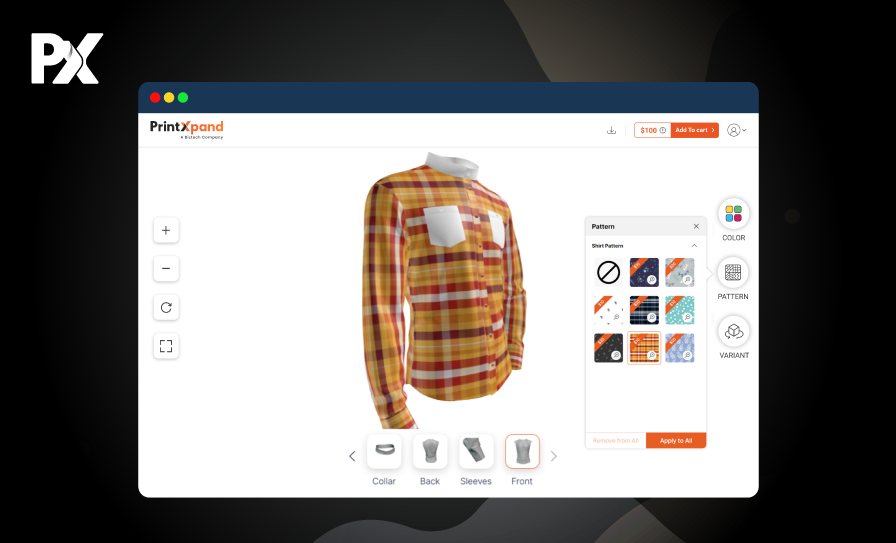
However, you can still have complete control over what they design as you can enable or disable the design areas as per your preference.
Hence, whatever the budget is, make sure that your tool has all the functionalities your customers would love.
Sell Custom T-shirts and Earn!
Want to start your t-shirt business online and make quick money? We’ve outlined all the essential steps to help you get started.
Step 5: Select the t-shirt printing methods you will use
After you are sorted with designs, it’s time to print! There are four commonly followed ways of printing t-shirts. All the four methods have their benefits and pitfalls. So the success of production depends on how much time you are willing to spend on the production and the printing method you use.
These are the commonly used t-shirt printing methods:
A. Screen Printing
When it comes to printing t-shirts in bulk, screen printing is one of the most popularly used methods. It also provides consistent printing and long lasting imprints. When there are more than four or five colors involved, it gets a little complicated for screen printing machines. So in such a scenario, it might take more time to print.
|
Pros |
Cons |
|---|---|
| Perfect for simple designs | Printing in multiple colors can be expensive. |
| Much More durable as compared to other methods | Takes more time with complicated designs |
B. Heat transfer printing
This type of printing has been around for several years. Photocopy machines and laser printers work really well on the heat transfer phenomenon. It involves printing designs from your PC and transferring them with iron.
Heat transfer might prove to be a traditional method for handling a t-shirt printing business. This is because you have to print fast and in larger quantities.
Here’s a little brief about laser printers:
Laser printers are quite popular for providing prints that are quite long lasting and don’t get affected by wash. Also, the fabric retains its natural feel after it is printed. It doesn’t look like a design has been unnaturally embossed or printed on t-shirts.
If you want to have t-shirts that look professional and attractive, investing into a Laser printer would be a good thing to do. Plastisol transfer is the latest form of heat transfer. This kind of printing is implemented on high quality heat transfer paper.
You can order stacks or prints from a printer and apply them on the t-shirts as and when you receive orders for t-shirt printing. Through heat transfer, you will be able to print images quite quickly.
|
Pros |
Cons |
|---|---|
| Easy to use even for those with no prior experience | Asks for a lot of time and undivided attention from the printer |
| Allows variety of colors and placements on a garment | Less durable as compared to screen printing and needs a lot of investment |
C. Direct-to-garment printing
This printer works like an inkjet printer and that is why there are no additional costs involved. It can print multiple coloured images directly on the t-shirts with perfection.
The results obtained from direct-to-garment printing are as good as the ones obtained from screen printing. Needless to say, it is way better than the quality produced by heat transfers.
Here’s a little brief about Inkjet Printers
Inkjet printers are quite cost-effective as compared to laser printers. Also, they give a bright and vibrant output. If you can accept a little less professional edge for low costs and brighter colour, Inkjet printer might be your way to go. The only drawback of this kind of printer is that their ink is a little expensive.
|
Pros |
Cons |
|---|---|
| Quick Turnaround time | Not advisable for bulk production |
| Gives vibrant and intricate designs | Difficult to give volume discounts |
D. Embroidered printing
It is an ancient printing technique whose origins go back to the 5th century BC. Embroidered printing is one of the most unconventional ways of printing. This is because unlike other printing methods, it uses a sewing machine that sews the design in the t-shirt.
Lots of polo t-shirts are printed using this method. Embroidery printing is also used to create corporate t-shirts.
This kind of printing is still preferred by many as the design looks quite original, professional, and elegant when printed on the t-shirt. It also lasts quite long and doesn’t come off easily.
|
Pros |
Cons |
|---|---|
| Screen printing is durable | Difficult to learn and requires additional efforts for printing large volumes |
| Gives a professional finish | Difficult to implement the embroidery of intricate and minute design |
Need help integrating a t-shirt designer tool into your store?
Explore the tool now and connect with our technical experts for a seamless setup.
Step 6: Select the right t-shirt supplier
Once you have decided to venture into the T-shirt printing business, you need to buy blank T-shirts for printing. Do a little bit of research and find out about a manufacturer who can provide you with good quality blank t-shirts for printing.
Garment distributors also help the new business owners to go through different T-shirt options to find the t-shirts within their price range. After a couple of orders and production, you will be able to decide on the price points and other factors for your t-shirts.
Here are a couple of things you should remember:
- Check the quality of the product first. Customers won’t return for repurchase if a pattern fades or cracks or a t-shirt shrinks or rips.
- Focus on the blanket shirt’s material and printing technique while preparing your design file.
- Additionally, maintain a good relationship with your supplier, as you lose time and money from your production schedule with every imperfect shirt.
Well, that’s not all! To ensure high-quality results, you also need to keep the below-mentioned things in mind:
1. Consider the Fabric Type:
- The fabric’s physical properties affect how the design looks after printing.
- Choose a material that complements the ink type and guarantees the durability of the t-shirt.
2. Standard Print Size and Placement:
- T-shirt designs must fit within three standard sizes: small, medium, and large.
- The design should be properly centered and not extend to the collar, sleeves, or hem.
- If printing in multiple locations, such as sleeves or the back of the t-shirt, ensure the design remains flexible.
3. Selecting Right Ink for Desired Effects
- A wide variety of inks are available in the market, and each of them offers different effects:
- High-density ink: Adds texture and an amazing dimensional look.
- Gel ink: Creates a thick and rubbery feel.
- Foil ink: Produces a shiny, embossed effect.
- Lastly, choose an ink that best suits the fabric you are using.
Step 7. Set Up The Printing Infrastructure
Once you are done deciding the type of printing method and t-shirt printing material, you need to set up a printing infrastructure or a facility wherein printing can take place without any glitches.
It is advisable to have a printing studio which is equipped with well-maintained printers along with a coating and a finishing unit.
Also, the printer should be able to print a number of designs on different quality fabrics. This is because the customers who demand printed t-shirts also might demand customized caps, bags, jerseys, etc. Here’s how you should go about the printing process:
- Decide on the color schemes: If you decide on your color palette first, you can take care of the details which are overlooked by the time it is too late. When working on an apparel order from scratch, it doesn’t matter whether you pick the garment first or the ink. But there definitely is a link between the two which will be visible in the final print. So you can simulate different inks and check garment color combinations by making mock-ups designs.
- Save a copy for yourself and another for print: Once you have received the final design from your customers, you need to save an editable file for yourself, so that changes can be made later if need be. If there are issues in your printer due to the size or resolution of the file, you might have to go back and make changes or ask your customer to do the same. In a worst-case scenario, they might have to start from scratch.
- Print the t-shirt: Last but not the least, you can print the t-shirt using whichever method you are comfortable with using the printer of your choice. It is better to hire professionals to do the job if you are not comfortable with the printing process. After printing the t-shirt you have to cure the garment and set the ink in the tshirts to ensure maximum washability.
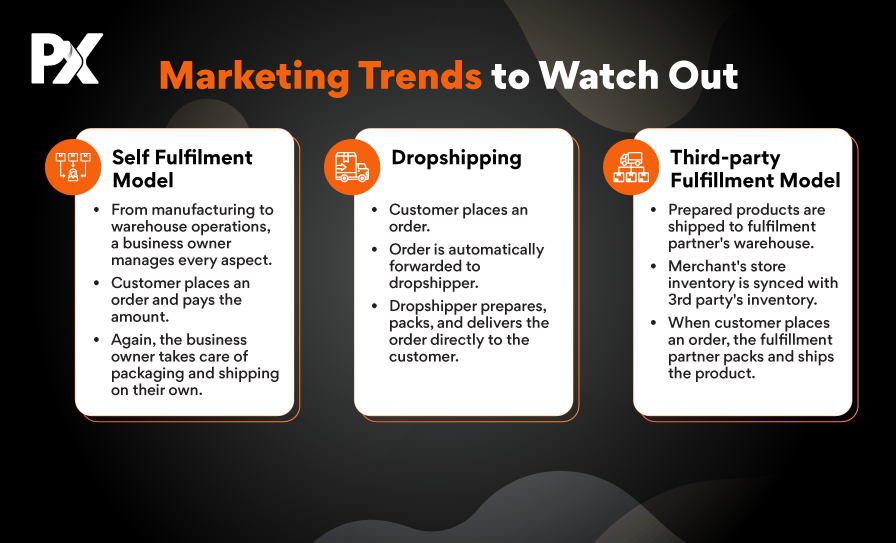
Step 8: Set Up Logistics Infrastructure
Once the t-shirt order is placed by your customers, it has to be delivered to them on time. You can ensure a smooth delivery process in 3 ways:
- You can take care of your orders independently with the help of your team.
- Sell your product through the drop-shipper who can take care of your orders.
- Liaise with a logistics company that can take care of your warehousing and fulfillment.
There are several advantages of packing and shipping your own t-shirt orders as it is cost-effective and flexible. So the companies that have just started with their business often choose to take care of their own logistics.
However, if your business flourishes and you have money to outsource, you can opt for third-party warehousing. You will be able to find several companies who will take care of storage, packing and shipping of your orders.
Step 9: Launch Your Store
Last but not the least, you can finally start selling some t-shirts! Invite your customers to unleash their creativity and encourage them to draw the designs to the best of their abilities. Ensure that the designer tool is user-friendly and the checkout process is simple. This will lessen the number of cart abandonments. Print the right designs on the right t-shirts and bring a satisfactory smile on the face of your customers.
Thinking about setting up an online t-shirt printing store? The best thing is that you don’t need coding skills! All you need is creativity and a good eye for fashion! Start small with minimal supplies and let technical experts with a pre-built product design tool and web-to-print software setup do the heavy lifting.
Ready to start your t-shirt printing business? Talk with our experts to know everything!
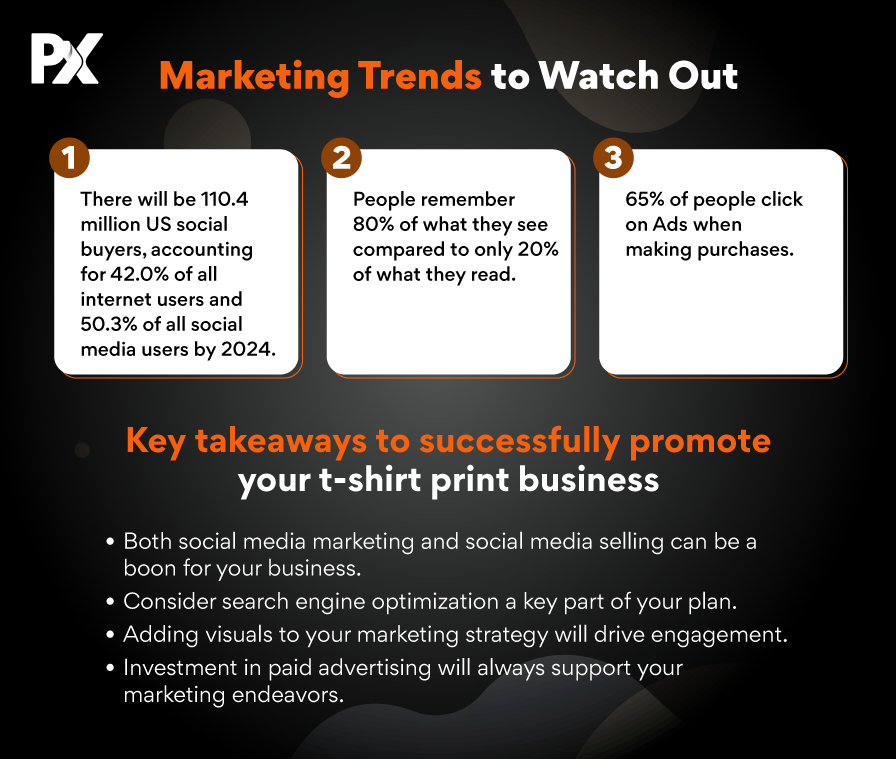
Step 10: Marketing Your Store
Start marketing your upcoming businesses through flyers, pamphlets, and business cards. Hand them out to the nearest organizations, businesses, and schools.
- Word of mouth promotion is also very important if you want the message about your printing business to spread amongst the locals.
- The right branding can establish your business as a trustworthy leader in your space. For that your logo and website will often be the first thing new customers browse for T-shirts. Hence, make sure to make a good impression.
- Wear your merchandise and step out. Click pictures, talk to people and put them on instagram. It makes a lot of difference.
- You can also give away printed t-shirts bearing the logo of your company. Don’t be hesitant to sponsor events, give online ads and use other paid marketing tactics.
- Conduct online polls and surveys on these channels and post consistently to get people to follow you.
Enable t-shirt customization in your store to attract and engage your customers for 2X business
growth! Understand how it works for your business here.
To Conclude
According to the latest statistics, eCommerce sales are likely to surpass $7.4 trillion in 2025. With more businesses getting online, competition is getting stiffer.
The above steps might provide a detailed guide on how to start t-shirt printing business, but they can’t guarantee a successful venture.
To stay ahead of others, you have to take all your business constraints into consideration – get the right vendors for web-to-print solutions, printing machines and t-shirts. You will also have to figure out the most cost effective way to get the t-shirts printed and delivered to your customers. And once all those are in place you have to figure out a winning marketing strategy to get more traffic. But if you do all these right, then there’s no stopping you from achieving success.
All product and company names are trademarks™, registered® or copyright© trademarks of their respective holders. Use of them does not imply any affiliation with or endorsement by them.
FAQs
Is T-shirt printing business profitable?
With the global demand for custom t-shirt printing expected to go from USD 5.89 billion to USD 20 billion in the next 10 years. So, starting a well-planned custom T-shirt printing business is for sure a profitable idea
What tools are needed to start a Tshirt business?
To make your T-shirt Business stand out, you need following tools:
- All the required tools for printing: heat press, printers, cutter, emulsion, transfer paper, inks and dryer
- eCommerce Store to sell your products
- T-Shirt Designer Tool for offering customization
Can my customers design their own Tshirts on my website?
Yes, with the help of a T-Shirt Designer Tool, your customers can personalize their own shirts.
Can I customize the PrintXpand T-shirt design tool according to my branding guidelines?
Yes, our team of experts will personalize the tool and design it specifically as per your business requirements.
Can I integrate the PrintXpand T-shirt design tool on Shopify?
Yes, our tool can be seamlessly integrated with any eCommerce platform including Shopify.
How much does the PrintXpand T-shirt design tool cost?
Charges of the tool depend upon the unique needs of your business. Take a personalized free demo now to know more.
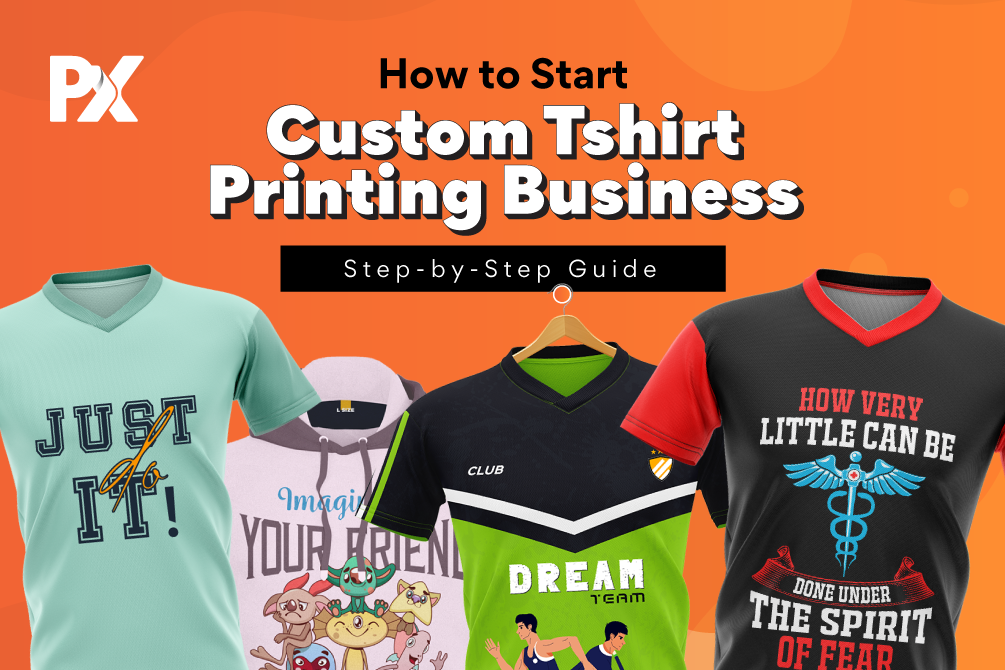
 Try the T-Shirt Designer Tool Now!
Try the T-Shirt Designer Tool Now!


